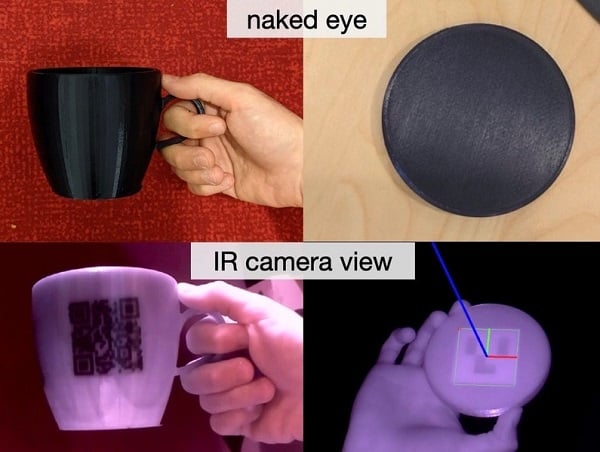A 3D-printing process developed at MIT creates barcodes and tags in the infrared spectrum to enable machines to track and identify objects. In place of the standard barcodes affixed to products, which may be removed, become detached, or become unreadable over time, these tags are unobtrusive due to their invisibility to the naked eye. They are also more durable, given that they are embedded within the interior of objects fabricated on standard 3D printers.
Inspired by the metadata included with digital music files, which tells the listener the name of the song, artist, genre, and so on, Ph.D. student Mustafa Doga Dogan wondered whether engineers could do something similar for physical objects.

MIT scientists built a user interface that facilitates the integration of common tags (QR codes or ArUco markers used for augmented reality) with the object geometry to make them 3D printable as InfraredTags. Courtesy of MIT CSAIL.
“That way,” Dogan said, “we could inform ourselves faster and more reliably while walking around in a store or museum or library.”
After hearing of a smartphone model with an infrared camera, Dogan sought a suitable variety of plastic through which infrared light could pass. He found a small German company that made customized plastic filaments. Using a spectrophotometer, Dogan analyzed the sample, finding that it was opaque to visible light but transparent or translucent to infrared light.
The next step was to experiment with techniques for making tags on a printer. One option was to produce the code by carving out tiny air gaps — proxies for zeroes and ones — in a layer of plastic. Another option was to use two kinds of plastic, one that transmits IR light and the other — upon which the code is inscribed — that is opaque. The dual-material approach is preferable; it can provide a clearer contrast and thus can be more easily read with an infrared camera.
The tags, called InfraredTags, could consist of familiar barcodes, which present information in a linear, one-dimensional format. Two-dimensional options — such as square QR codes and so-called ArUco (fiducial) markers — can potentially pack more information into the same area.
The MIT team developed a software user interface that specifies exactly what the tag should look like and where it should appear within a particular object. Multiple tags can be placed throughout the same object to allow information to be read from multiple viewing angles.
“InfraredTags is a really clever, useful, and accessible approach to embedding information into objects,” said Fraser Anderson, a senior principal research scientist at the Autodesk Technology Center in Toronto. “I can easily imagine a future where you can point a standard camera at any object and it would give you information about that object — where it was manufactured, the materials used, or repair instructions — and you wouldn’t even have to search for a barcode.”
The researchers’ paper, “InfraredTags: Embedding Invisible AR Markers and Barcodes into Objects Using Low-Cost Infrared-Based 3D Printing and Imaging Tools,” will be presented at the ACM CHI Conference on Human Factors in Computing Systems and will be published in the conference proceedings.